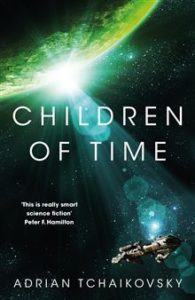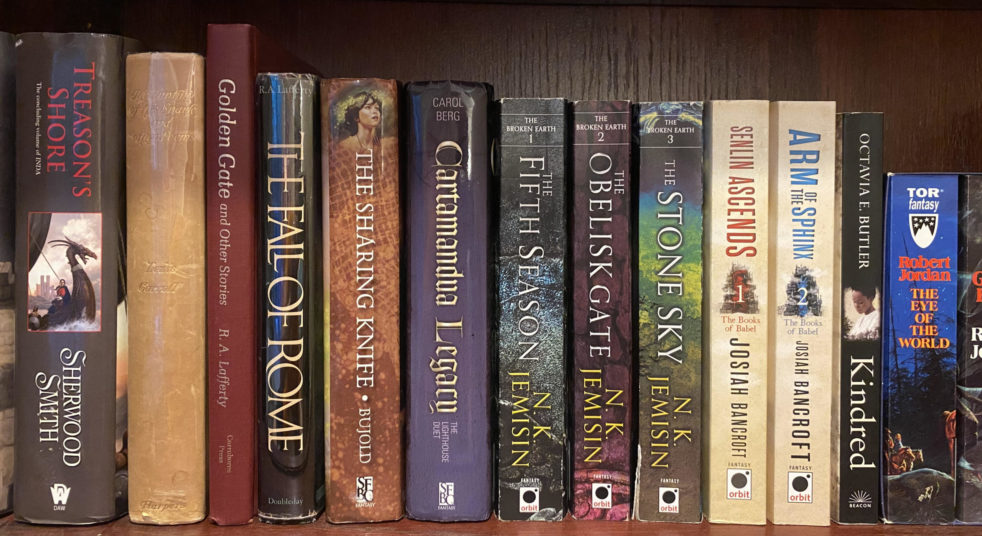
I read Adrian Tchaikovsky’s Children of Time before I started blogging, and it played a huge role in getting me to reconsider my generally negative stance on hard sci-fi. It’s absolutely tremendous work. Ever since, I’ve been looking for an opportunity to get to the sequel, Children of Ruin. And, now that I have, I’ll review what had been called a duology—although it appears that that may be out of date, as a third installment is in the works—together. I don’t expect readers of this review to have read either book, so I won’t include spoilers beyond the basic premise. The second book isn’t a true standalone, but it stands alone well enough that it’s easy to discuss without betraying key elements of the first.
Children of Time is a generational novel, following two major groups across the centuries. The first is a terraforming project gone wrong, one that led to spiders slowly evolving as the dominant species on a planet that had lacked intelligent habitants. The other is a group of humans who have scraped together bits of technology out of the rubble of apocalypse and set off to find a new home on a planet listed as the site of an archaic terraforming project. You can see where this is going.
And Children of Time is astounding work. The human characters are unexceptional, but the dive into the development of spider culture is absolutely fascinating. The reader understands that the book will end in conflict, but the novel doesn’t rush us toward that conflict. It lingers in the details of how a species of line huntresses became a society, and how that society grew to dominant their world and to design their own tools and technologies and social structures.
The ultimate conflagration is compelling, but it’s the time the book spends on building an alternative society without the anthropocentric focus that makes it special. Tchaikovsky goes into painstaking detail to make the world come to life, and he zooms in on key moments in cultural development that make it easy for the reader to emotionally attach to the spiders. We get fascinating and sometimes heart-wrenching tales that show something important about societal development, and then we skip a century or two and get another one. Even without the human conflict, it would be an interesting novel. That the end pulls it all together is simply the cherry on top. This may not hit for readers who dislike hard sci-fi or generational structures (and perhaps not for arachnophobes either), but if those elements aren’t actively offputting, it’s a must-read.
And then Children of Ruin tries to recapture the magic, with mixed results. Both positive and negative reviews of the sequel note that it’s the same premise as Children of Time, but on a different planet with a different focal species. If you liked Children of Time, you could expect more of the same, but there wasn’t going to be an additional wow factor.
I obviously liked Children of Time quite a bit, so that description didn’t bother me. But Children of Ruin isn’t the same in all the right ways. It has a similar (though not exactly the same) generational structure, but the target species is a little bit more alien, and so the dives into the budding new culture are shorter and sketchier. I loved those sections in Children of Time, so I was disappointed to see them truncated in the sequel, but it’s not a deal-breaker if that extra space is used to add a new wrinkle or even cut in favor of a streamlined story. But, while Children of Ruin does add another wrinkle, it’s just as lengthy as its predecessor, and the extra time is mostly spent on the human characters—the expected collection of eccentric subject matter experts. And those additional characters aren’t bad, but they’re not enough to bear the weight of all that extra space. Add in a plot that’s fairly predictable for readers of the first book, and it just doesn’t hit the heights of Children of Time. The storytelling is strong enough to make the sequel an enjoyable read, but it isn’t a must-read.
Recommended if you like: hard sci-fi, non-human perspectives.
Can I use it for Bingo? Both books are hard mode for First Contact, are over 500 Pages, and have an X of Y title. In addition, Children of Time has a Forest Setting.
Overall rating: Children of Time gets 18 of Tar Vol’s 20. Children of Ruin scores 14. There’s no need to rate them as a unit because Children of Time has a perfectly satisfying ending and can be read as a standalone.
